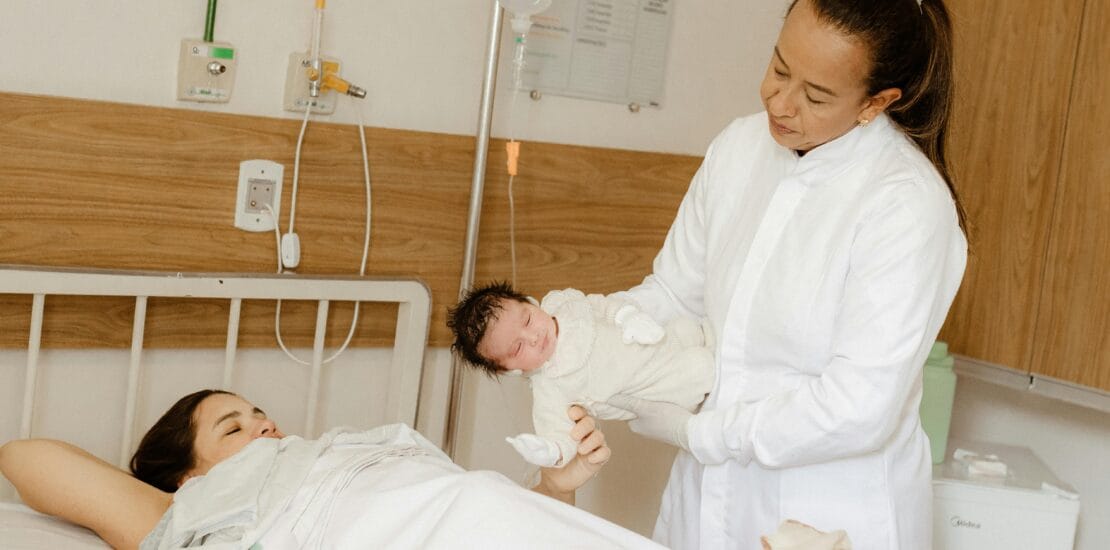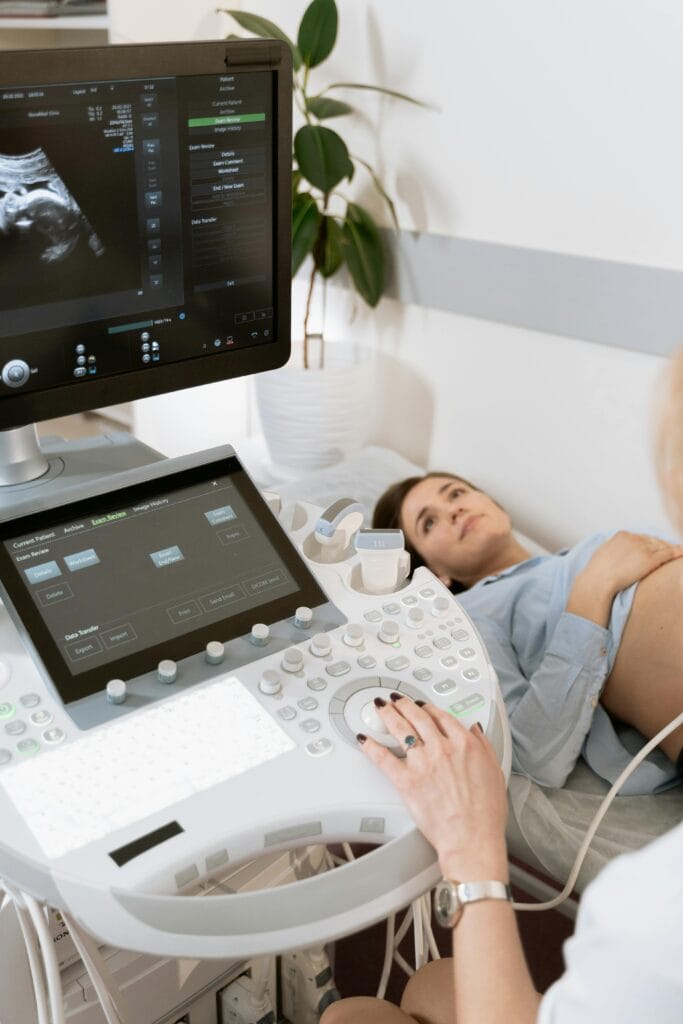Medical Dissertation: PROMPT Course for Safer Maternity Practices
- 22 October 2024
- Posted by: OAH
- Category: Nursing & Healthcare

This is a sample medical dissertation focusing on the PROMPT course as a tool for improving maternity care and patient safety. This healthcare dissertation sample explores how the PROMPT course enhances teamwork, communication, and clinical outcomes in obstetric emergencies. This will also help us understand safer maternity practices.
Hire us for your Assignment Help Online. Contact us now!
Medical Dissertation Sample
The PROMPT Course: Enhancing Maternity Care Through Team-Based Training
Table of Contents
Introduction
An important component of facility-based services is concerned with mother and neonatal health, however, facilities’ capacity to respond to obstetric emergencies is a challenge. WHO indicates that several complications that affect women during pregnancy and childbirth or newborns could be prevented if the women sought proper care and if they were attended to appropriately; statistic reveals that about 295000 women die in labor globally and 99% of these deaths could be prevented through prompt of appropriate intervention during pregnancy and childbirth. To reduce the maternal mortality ratio from 2010 to the vision set at 2025 to half, there is the need to deal with system causes as seen in the Ockenden Report and the EMBRACE 2023 document. All these reports highlight some of the defects in maternity services such as those of the Shrewsbury and Telford Hospital NHS Trust where poor practices resulted in more than 200 babies dying. However, the mortality rate of the mother has risen by 15 % (RR 1. 15, 95 % CI 0. 96-1. 38)
The PROMPT course that is discussed in the research is an acknowledged training course for enhancing the outcomes of obstetric emergencies. Originally designed and implemented in answer to the call for improvements in the management of obstetric emergencies, PROMPT is a form of an evidence-based, and simulation-based training intervention aimed at improving clinical practice in the maternity care setting. PROMPT was originally comprised of maternal midwifery and obstetric emergencies and was later modified in 2017 to include anesthetic emergencies after it was realized that anesthetists do play a very significant and central role in the management of these emergencies. The course is set out to promote the optimization of teamwork, fine-tune clinical skills, and develop the speed of dealing with maternal emergencies in general with the expectation to improve patient outcomes and the quality of overall service provision as its core objectives.
As portrayed in the literature, PROMPT is effective in enhancing the maternal and neonatal consequences. Research carried out on the effectiveness of patient safety of the PROMPT program showed that application effectively decreased occurrences of postpartum hemorrhage and neonatal asphyxiation. In addition, Miller et al. suggested that PROMPT training had a positive effect on adhering to clinical protocols, and the instances of SMM were decreased in several facilities. Intensive emphasis was made on interdisciplinary staff cooperation, communication, and decision-making processes that constitute the key factors that determined the effectiveness of the training and interactions in the management of obstetric emergencies as identified by Walker et al. The fact that PROMPT involves the imitation of real-life clinical environment entails teamwork among obstetricians, midwives, anesthetists, and pediatricians in a manner that also improves patient outcomes
This is important given that this study can also add, to the existing body of knowledge on the effectiveness of the PROMPT courses and thus contribute to the improvement of maternal and neonatal health. This change can be brought about by enhancing the competencies and perceived self-efficacy of the maternity care teams, which is the purpose of PROMPT in reducing adverse outcomes in obstetric emergencies. The views of other studies, including Draycott et al and Miller et al have also supported the viability of using PROMPT in increasing managerial competency in Maternal and Neonatal mortality. This research aims at extending the existing literature and effort for enhancing the quality of Maternity Care and supporting global health targets for maternal and newborn health.
Challenging Dilemma:
There are still high incidences of morbidity and mortality among mothers and their neonates, especially due to complications that can be averted during childbirth. Even though most developed countries have improved their technology and practices in the management of childbirth, many healthcare facilities still fail to handle obstetric emergencies well mainly because practitioners receive little training and interdisciplinary collaboration1. The lack of better training is crucial, especially in training the multi-professional teams to handle obstetric emergencies effectively and expeditiously6. Practical Obstetric Multi-Professional Training (PROMPT) has been developed as a solution to these problems by offering simulation-based, evidence-based training for enhancing communication, teamwork, and decision-making in the maternity field.

Aim and objectives:
Aim:
The proposed study will seek to look at the extent to which PROMPT courses facilitate the enhancement of maternity services by analyzing their success in altering clinical results as well as professional skills in handling obstetrics emergencies. In particular, it aims to investigate possible improvements to patient safety as a result of this training and other determinants of PROMPT implementation across different organizations. The data will be collected through the interview of the healthcare professionals who have completed the PROMPT training and therefore the assessment of the advantages as well as the difficulties of the program.
Objectives:
- To measure the usefulness of PROMPT courses as a quality improvement intervention in the provision of obstetric care, focusing on their impact on maternal and neonatal health.
- Examine the success of the PROMPT training in enhancing the communication ability of obstetric teams, comprising anesthetists, and the change in management of obstetric emergencies.
- To evaluate the integration of PROMPT training into existing maternity services, assessing its impact on service delivery and identifying opportunities for consistent implementation across various healthcare settings.
Research Questions:
- What are the effects of the PROMPT training program on working relations and communication between anesthetists and other members of medical teams during obstetric complications and how does it influence the results?
- How does a multi-professional team training program PROMPT affect the performance of obstetric emergency?
- What challenges exist for participating organizations to undertake and complete PROMPT training and how can these be managed to ensure effective implementation and participation?
Literature Review
Introduction
The PROMPT course is a multi-professional training that was developed to improve the outcomes of maternal care by improving the teamwork process during obstetric complications. As introduced in 2008 in the United Kingdom, the PROMPT course is designed to lower figures of maternal and neonatal mortality by protecting women’s lives with simulation-based training and practice of emergencies.
PROMPT is a well-developed, multidisciplinary training of Obstetric Emergencies, which is quite helpful in enhancing the management of Obstetric cases. The training is in the format of morning lectures and afternoon role-play scenarios/simulations to prepare participants to deal with the most encountered obstetric emergencies. The course emerged because of concerns and imperfections of emergency obstetric care delivered, aimed to enhance the outcomes of childbirth for the mothers and the neonates4
Basic Steps of PROMPT Training:
Introduction and Briefing: First, participants are informed of the general training goals and objectives by recently updated evidence-based lectures followed by simulations. In this phase, the proper setting of the emergency simulations is established as well as the assertion of the roles of communication as well as teamwork.
Scenario-based Simulation: A low-fidelity scenario content is presented to the PROMPT participants as realistic obstetric emergencies are difficult to replicate for training purposes. It requires leadership competencies, mentoring competencies, clinical competencies, and non-clinical competencies as the participants are expected to handle the situation effectively.
Debriefing: Each simulation is followed by a debriefing which utilizes a specific debriefing model. This enables the participants to dwell on their presentations, and the positive and negative aspects of. It examines competencies of specific, as well as interpersonal and cognitive nature, including technical abilities, pressure and stress, and teamwork and communication during critical and high-stress events 10.
Feedback and Continuous Improvement: Course feedback is an important component of the course and has consistence feedback from instructors and peers. It helps to form the continuous loop to evaluate and enhance so that the participant gets a clear picture of strengths and weaknesses at the end of the training11
Implementation in Real-world Settings: The skills being taught in PROMPT shall be most effective when practiced clinically in the true sense. Such training aims at improving healthcare teams for increased patient safety, effective communication, teamwork, and leadership skills among the teams.
The Development and Evolution of PROMPT
PROMPT is known as Practical Obstetric Multi-Professional Training; it was designed due to existing deficiencies in the training of professionals who are involved in the management of obstetric emergencies. As per the study of Draycott et al.,2 PROMPT was designed as a result of perceived shortcomings in managing these emergencies, especially the poor management of real-life emergencies. The purpose of the course, which was an emergency simulation, was to give training in emergent situations without given risks, where the medical team could work on training and improving in simulated conditions.
PROMPT was first instituted in 2008 by a group of professionals under the leadership of Professor Tim Draycott of Southmead Hospital in Bristol in the United Kingdom of Great Britain and Northern Ireland. This was due to health complications such as high maternal and neonatal mortality rates which required an approach that focused on active, practical knowledge consumption. Describing the course as a combination of medical training and communication, teamwork, and leadership, the authors stressed the difference of this program from others in that the training seemed to be dominated by technical skills.
Due to the feedback from the participants and stakeholders, PROMPT has also been developed to be more dynamic in its structure as well as having the ability to meet the current issues of an obstetric field. This continuous improvement has made PROMPT the training model of reference around the world and versatile irrespective of the economic and health status of any country.
Effectiveness of PROMPT in Improving Clinical Outcomes
Numerous researches prove the efficacy of PROMPT in enhancing clinical outcomes in the field of maternity. In an Australian hospital, Shoushtarian et al. highlight that there was some improvement regarding maternal and neonatal morbidity after using PROMPT. Similar to this study, Pritchard et al., also analyze that there are fewer occurrences of postpartum hemorrhage after completing PROMPT training.
The earlier developed PROMPT course has been attributed to a decrease in stillbirth as cited by Lewis et al., The authors point to this as better team coordination and the ability to make quick decisions that had been fostered by the course. Moreover, Kumar et al. noted that PROMPT has a benefit that enhances patient outcomes, the nurses’ competencies, assurance, and confidence in emergencies.
Outcome 1: Patient Safety
Ellis et al. had earlier reported the results of a formally designed randomized controlled trial of PROMPT training for the care of patients with eclampsia, a serious obstetric emergency. From this aspect, this improvement can be attributed to the fact that the course encourages group work and interprofessional work, as acknowledged by Freeth et al.11
Lucas et al. highlight the aspects of promotion and evaluation of training programs such as PROMPT to maintain safe practices for patients. As to this issue, the authors rely on the use of quality indicators for evaluating the impact of those interventions; this opinion is shared by Boulkedid et al.
Outcome 2: Staff Performance and Teamwork
The PROMPT course has increased the efficiency of the staff and interprofessional collaboration in maternity services. Crofts et al.10 acknowledge that simulation training emphasizes the communication and teamwork of the healthcare personnel. This is in agreement with Siassakos et al., where components for effective training were suggested because they incorporate aspects like simulated practical exercises and sessional reviews.
In another study by Lippke et al, it was revealed that the communication intervention within the developed PROMPT model enhanced the relations of staff and minimized the hierarchy. This improvement in what transpires among the members of the team is critical when it comes to the effective delivery of services to the patients as well as the management of emergent situations.
Outcome 3: Patient Satisfaction
The level of satisfaction from clients/ patients is a significant measure of the quality of services, and the current study revealed that the PROMPT course had proposed some solutions that enhance this aspect of Maternity Services. Taylor et al. touch on the aspect of patients’ perceived satisfaction score, where patients have described contents of their satisfaction scores as having had much-improved levels of satisfaction after undergoing the training offered by PROMPT. Patients who followed this course established that communication and safety during care had increased, which is my emphasis on patient care approaches.
Moreover, Knight et al. specify more lessons from the PROMPT course and emphasize that patients should be engaged in evaluation as well. Such a feedback loop guarantees that training programs are relevant as regards the patient needs and expectations thus improving the quality of Health care services.
Challenges in Implementing PROMPT in Resource-Limited Settings
However, the strengths of using PROMPT are clear, and its execution in poor-resource environments has its dynamics. As stated by Althabe et al12, it is critical to understating that quality improvement needs to be cautiously approached to fit the needs of LMICs. In this regard, they claim that despite some of the criticism that has been associated with the use of PROMPT, it can be scaled to suit the different requirements of different healthcare settings and therefore make it more relevant.
Evaluation of PROMPT’s Long-Term Impact
Assessing the success of the intervention’s implementation on maternity services is important in considering the overall impact of PROMPT. Gebhardt and de Waard also stress the importance of long-term studies to determine the degree to which the application of PROMPT training influences practical results and patient safety. In this way, such evaluations can help identify the course’s contribution to maintaining quality improvement throughout the institution.
Koome performed a dissertation on the pattern of use of maternal health quality standards after training offered under PROMPT showing increased compliance with protocols and guidelines. This speaks to the course’s ability to promote the safety culture and best practices in the provision of maternity services.
Conclusion
PROMPT has taken a positive and dynamic leap in terms of conformity as an ideal framework for the further improvement of the quality of maternity services on cross-sectional aspects ranging over clinical effectiveness, patient safety, staff efficiency, and patient satisfaction. Such applicability to different environments as well as incorporation of the new technologies make it even more useful and effective. Thus, the limitations persist as to the integration of PROMPT within the resource-limited settings; yet, the necessary approaches should be modified to address the existing barriers and enhance the utility of the framework.
Healthcare systems are developing nowadays, and thus, the PROMPT course remains a reliable guide to improving maternity care while including multi-professional education and learning. Future research should examine the follow-up results as well as the dissemination of the PROMPT program and pursue the question of identifying novel approaches for the implementation and further and more comprehensive internationalization of PROMPT, thus helping to improve the security and efficiency of the respective fields of activity on a global level.
Methodology
Research Design
In the current study, the research design was qualitative in that it aimed at exploring and explaining the perceptions and apprehensions of the professionals who had undergone the PROMPT course. Qualitative research was only applicable in this study because it helped in presenting the many-faceted contexts in which the health care professionals worked. This study was fundamentally different from quantitative research that aspires to generate numbers and values concerning a given phenomenon or concept; this study sought to comprehend the participants’ experiences and interpretations of the phenomenon under investigation in their context.
Thematic analysis was chosen as the method for this study for several reasons, including it being practical, and flexible, as well as reliable and valid in defining, categorizing, and describing themes in qualitative data. Thematic analysis can be considered very appropriate for the present study because it facilitated the exploration of complexity and nuance inherent to the participants’ stories. This approach assisted in establishing the constructs that defined the PV and sources of change after the PROMPT course about maternity services’ improvement endeavors.
In this study, thematic analysis was used on the data obtained from the semi-structured interviews from the sample group as anesthetist consultants. This template for the interviews was intended to explore the participants’ perceptions and utilization of the PROMPT course, especially how it impacted their practice and patient care. Consequently, the research adopted a qualitative method of research and the study used thematic analysis to determine how the PROMPT course acted as a tool for improvement of the quality of maternity services, depicting the strengths and weaknesses of the course.
Participants:
The participants in this study were exclusively consultant anesthetists working in the maternity unit at King’s College Hospital. No obstetricians, pediatricians, or midwives were included in this study to avoid any hierarchy and differences in perspective based on specialty.
For participant recruitment, internal email invitations were sent only to the obstetric anesthetists by the departmental secretary. A diary was maintained to schedule these interviews; however, there was limited online response. All participants were happy to participate by asking verbally in response to an email sent. One consultant sent an email apology for not being able to participate being away on holidays.
The criteria for inclusion in the study were straightforward: all consultant anesthetists who had attended the PROMPT course as participants or taught as trainers were considered, without a specific time duration being imposed on their participation.
Data Collection
For this study, interviews were conducted with anesthetists who are practicing in the maternity unit of King’s College Hospital using semi-structured interviews. The questions of these interviews were designed to seek the participant’s perceptions of the PROMPT (Practical Obstetric Multi-Professional Training) course and its relevance as a quality improvement intervention in maternity services.
Recruitment Process
To have a variety of perspectives, a purposive sampling method was adopted to enroll the participants. The researcher sent the anesthetists an email invitation that sought to explain the purpose of the study, the procedures that would be involved, and whether the anesthetists were free to participate or not. This email also contained a participant information sheet as well as a consent form for those willing to participate.
Interview Procedure
Scheduling and Location:
The interviews were conducted in person in the anesthesia office to maintain confidentiality and ensure ease of access. Nine interviews were conducted face to face, and three were held via Microsoft Teams due to the researcher’s change of circumstances.
Duration: An interview took about 40 to 45 minutes to have a deeper discussion of the participants’ experiences and views, at the same time.
Topic Guide: The use of an interview schedule had open-ended structured questions that aimed at capturing an elaborate description of the participants’ experience of undertaking the PROMPT course. The guide encompassed general questions to encourage the participant to provide their views and additional questions that aimed at specific aspects of the topic. Key topics covered included:
Interview Guide
The interview guide was established from the set of research questions and literature to the study. It included questions related to:
- It aims to explore the overall participants’ experiences with the PROMPT course
- The perceived benefits of the course
- Issues experienced during and after the completion of the course
- Applicability of the course for professional practice and patients’ lives
- Recommendations for enhancing the course and its implementation into clinical norms
Data Analysis
Thus, thematic analysis concerning Braun and Clarke’s six-phase process was applied to the interview data. This method is useful in the structured identification, analysis, and documentation of patterns (themes) in the data. Below is a detailed explanation of each phase of the analysis:
1. Familiarization with the Data
In this study’s initial stage, the researcher adopted the method of open coding to become conversant with the contents of the data. This process involved several steps:
Transcribing the Interviews: All the carried-out interviews were taped and the tapes were transcribed word by word. This step made sure that all the spoken words said by the participants would be recorded in a written format as said, retaining all the details of the responses given.
Reading and Re-reading Transcripts: The researcher attempted to read the transcripts several times. The act of rereading helped in understanding the collected data better and in discovering first impressions or an overall vision of the data.
Noting Initial Ideas: Some aspects, ideas, or even patterns may come to light during the process of reading; so, the researcher documented them in the form of notes. These are notes that provided working hypotheses to help in the further stages of analysis.
2. Generating Initial Codes
The second process that involved the sample data was systematic coding. Coding is the assignment of specific qualitative tags to segments of data that are regarded as pertinent to the research questions.
Systematic Coding: In the coding process, the researcher made her way through the entire program while tagging interesting features with codes. The numbers of each code corresponded to a particular keyword or notion about the participants’ engagement with the PROMPT course.
Organizing Codes: The codes were written down and filed under the relevant categories by using qualitative data analysis tools. With the help of this organization, the manager managed to address the problem of an overloaded large amount of information and, at the same time, prevent important information from being lost.
3. Searching for Themes
In this phase, the researcher started to look for the big picture by developing potential themes of related codes.
Collating Codes into Themes: Comparison was made on codes and when two or more codes contained similar characteristics they were grouped into potential themes. In this step, codes that encompass the same issue of the research questions were put in the same category.
Gathering Relevant Data: All gathered data that could be relevant to each potential theme were collected. It helped to avoid the situation when numerous points were deduced from one source and ensured that every theme had contemporary proofs from the dataset.
4. Reviewing Themes
This phase involved purifying the possible themes with a view of making them mirror the data collected.
Checking Themes Against Coded Extracts: The researcher reflected on each of them about the coded extracts. This step ensured that the themes appropriately captured the information coded from the scripts.
Reviewing Themes Against the Entire Dataset: Themes were also discussed in the context of the entire dataset The authors also wrote about the themes in the data. This wider sweep of thematic analysis helped to ensure that the themes fit and built upon one another to offer an opposite interpretation of the data.
Generating a Thematic Map: Specifically, by moving to a thematic map, the interrelatedness of themes could be represented easily. This map was useful in identifying how the themes having relations affected the achievement of the overall goal.
5. Defining and Naming Themes
In this phase, the researcher more specifically and distinctly defined all the emerged themes.
Ongoing Analysis: Working with the concepts, it was adjusted during the analysis to refine the details of each theme. To extend, the researcher scrutinized the themes in the research study to confirm that they captured the participants’ experiences and perceptions of the study variables.
Defining Themes: It was possible to define the concept of each of the identified themes clearly. These definitions defined what each theme was about and how the themes were related to the research questions.
Naming Themes: Official and brief labels were given to each theme. The names used were simple and were derived from the fundamental aspects of the themes.
6. Producing the Report
The last process was the integration of the research results and writing them in the manner of an academic paper.
Selection of Extract Examples: Specific and diverse support for the identified themes was found within the data to enhance the instances’ clarity. These examples as well as gave ontological facets of the themes and enriched the report.
Final Analysis of Extracts: The selected extracts provided the fundamental lens through which each case was subsequently analyzed about the overall research questions.
Relating to Research Questions and Literature: These themes were juxtaposed against the research questions posed at the beginning of the study and similar works in the literature. This step made sure that the findings made had been viewed or related to the broader field of study.
Producing the Scholarly Report: Thus, the final report with the topics and descriptions of the examples, as well as the main results and conclusions, were prepared. This paper sought to give a logical and persuasive account of the findings to describe and explain the participants’ experience and perceptions of the PROMPT course and, in turn, the experience and usefulness of the course as a quality improvement tool in maternity services.
The systematic way of analyzing data enabled the data to undergo thorough analysis by arriving at themes that give a holistic and rich understanding of the research topic.
Ethical Considerations
Strict ethical considerations are critical at every stage of the research. All participants sign a consent form and thus its purpose and participants’ rights are explained. Specificity is kept low and recordings and transcripts are kept secure so that the identity of participants cannot be determined easily.
Trustworthiness and Rigor
Methods such as data source triangulation are used to ensure the credibility of the study. This strategy improves the credibility, dependability, and confirmability of the research results obtained.
Therefore, the design of the study as a qualitative study with a thematic analysis approach is suitable for the investigation of healthcare practitioner experiences and perceptions of the PROMPT course. Such a method enables the development of rich and informative perspectives regarding the usefulness of the course as a quality improvement strategy for maternal services. About the study on the PROMPT course, data source triangulation may entail gathering information from a diverse group of health care practitioners, for example, obstetricians, midwives, anesthetists, or from a variety of health care facilities for instance hospitals in different areas. This approach helps to eradicate prejudice that is usually obtained from experiences of a limited data source of the particular group; thus, the credibility, dependability, and confirmability of the research findings improve.
Thematic Analysis
The thematic analysis of the PROMPT (Practical Obstetric Multi-Professional Training) course impacts the participants about the changes in clinical practice, training methodology, and interprofessional relationships. It is also important that issues like the relevance of content and training, facilitation of teamwork, and ideas to enhance the course are fitted under these headings. The direct quotes of the participants illuminate their understanding and attitude to the program and share the positive aspects of the PROMPT training program as well as its potential for improvement.
- Training and Skill Development
The effectiveness of PROMPT in bridging the gap between theory and practice was a recurring theme. Participants pointed out discrepancies: “What is put on paper in theory with the objectives of what PROMPT is supposed to achieve as opposed to what you see in real life…” Despite these challenges, many acknowledged its impact on real-world scenarios: “The practical translation from the day of PROMPT to an everyday occurrence in labor ward… is the bare minimum.”
The role of course in enhancing clinical practice was acknowledged, with one participant stating, “It helps us to deal with patients more promptly in that way it does improve the quality of patient care.” Others highlighted the course’s importance in fostering teamwork and communication: “PROMPT is key in improving multidisciplinary effective team working.”
- 1.1.Importance in Complex Scenarios:
PROMPT is helpful when training healthcare professionals on how to manage various critical and technically challenging situations for example managing eclamptic patients or managing cases of shoulder dystocia. All manifest both clinical and non-clinical skills, which are hallmarked by the training offered in these difficult settings.
- 1.2. Refreshing Essential Knowledge:
The course is regarded for updating or brushing up on such basic knowledge that one does not use frequently but is crucial now and then during medication dosage or hospital rules and regulations. It helps in making sure that the healthcare professionals don’t lapse on the modern-day best practices.
Emergency Preparedness:
- 1.3. PROMPT empowers the participants with the skills in the assessment and management of obstetric patients in a standardized way as one team. The training is accredited and seen more for its capability to effectively prepare practitioners to address emergencies specifically those encountered commonly in day-to-day practice.
- 1.4. Balance Between Basic and Simulated Training:
Participants emphasized there is the need to balance basic and advanced simulation within PROMPT. However, the anesthetists are trained to encounter emergencies out of obstetrics anyway. The dynamics of the team in maternity changes due to multi-professional team members and dealing with two lives (maternal and fetal). Basic knowledge is valued, but frequency of practice is considered essential to remain skilled to perform under stressful situations.
Need for Repetition
- 1.5.Training frequency was agreed upon annually as a multidisciplinary consensus. Annual attendance assists participants in refreshing their knowledge and skills and keeps them updated with policies and protocols in case of an incident.
2. Effectiveness and Implementation of PROMPT
The effectiveness of PROMPT in bridging the gap between theory and practice was a recurring theme. Participants pointed out discrepancies: “What is put on paper in theory with the objectives of what PROMPT is supposed to achieve as opposed to what you see in real life.” Despite these challenges, many acknowledged its impact on real-world scenarios: “The practical translation from the day of PROMPT to an everyday occurrence in labor ward… is the bare minimum.”
The course’s contribution to enhancing clinical practice was acknowledged, with one participant stating, “It helps us to deal with patients more promptly in that way it does improve the quality of patient care.” Others highlighted the importance of the course in fostering teamwork and communication: “PROMPT is key in improving multidisciplinary effective team working.”
2.1 Bridging Theory and Practice:
This sub-theme has emerged to capture that while some participants comprehensively understand and appreciate the key theoretical aims of invited to PROMPT, they do not believe that these are fully acquired in actual practice. There was a concern that what was designed, was not well implemented in practice.
2.2 Impact on Real-World Scenarios:
While there were apprehensions and analyses on how to engage multidisciplinary teams and get the best outcomes to implement PROMPT. The element of the theory-practice gap, maintaining a high standard of training, and getting positive outcomes in real life from this tool is challenging. The net impact is a positive influence on real-life clinical situations, though in some cases it was considered as having a relatively modest effect.
2.3 Enhancing Clinical Practice:
It has been attributed to enhancing the delivery of healthcare as PROMPT makes healthcare workers more efficient when addressing patients’ needs.
2.4 Fostering Teamwork and Communication:
The course is highly appreciated and useful for enhancing teamwork and communication of the multidisciplinary team members. It is necessary to be situationally aware and understand multiple specialty perspectives to deliver safe care.
3. Multidisciplinary Coordination
PROMPT’s role in bringing different specialties together was consistently highlighted. One participant noted, “PROMPT is about bringing the focused care from each specialty together to make it more coordinated.” However, concerns were raised about disproportionate representation: “The more I see PROMPT being run in the hospitals, the more I see it becoming a very much midwifery run faculty course.”
The importance of interprofessional communication and collaboration was emphasized: “It’s a team-building exercise… It makes you more confident in yourself and other people.” The course’s ability to improve teamwork across disciplines was noted, with participants acknowledging that “PROMPT is multi-professional because often in an emergency no one works in silos… the midwives must know what the airway emergency is.”
3. 1 Coordination Across Specialties:
PROMPT has received acclaim for effectively encouraging treatment by various specialties in the context of an integrated approach. This helps in making it easier for each specialty to collaborate better during an emergent situation.
3. 2 Disproportionate Representation:
Some participants stated that PROMPT is too midwifery oriented they are concerned that it may create an imbalance between representations of different specialties.
3. 3 Team-Building Exercise:
Some of the benefits include a team-building activity because it helps boost the morale of different members of the team and improves inter-disciplinary coordination.
3.4 Improving Teamwork Across Disciplines:
PROMPT pays particular attention to cooperative and co-ordinate work in emergencies, while all members of a team will be able to recognize and meet the needs of other team members.
4. Course Structure and Design
Participants expressed varied opinions on the course structure and design. While some appreciated the balance between theory and practice, others felt that “the theory can be delivered in a more convenient way like online… then in the afternoon when you’re not fresh anymore, you do the real simulation.” The practical application of the course was valued: “I find the simulation more interesting than the lectures… it was probably better face to face rather than just on the computer.”
Concerns about the course’s length were also raised, with one participant stating, “Sometimes I feel it’s a bit long and sometimes it gets a bit boring.” Another added, “I think one day course is enough because you are refreshing every year.”
4. 1 Balance Between Theory and Practice:
Referring to the theoretical part and practical simulations of PROMPT, participants’ attitudes to the balance of both aspects are rather diverse. A few indicate that theoretical aspects may be properly taught through the web while practice scenarios must be done face-to-face.
4. 2 Practical Application:
Most of the participants preferred simulation rather than lectures. The simulation approach is reported as more effective in reinforcing the training.
4. 3 Course Length:
Some of the criticisms leveled against the course lectures are that it can sometimes take too much time with not much recall or recollection in real life, thus contributing to participants’ boredom.
4. 4 One-Day Course Format:
Certain respondents suggested that a one-day knowledge refresher annually is ideal provided that no massive variations in curriculum and patient management are happening from year to year. However, the course manual is not updated every year as well.
5. Challenges and Limitations
5. 1 Practical Implementation:
Participants identified several challenges related to the PROMPT course. A key issue was the lack of practical implementation: “It’s not necessarily implemented in real life… I feel prompt, unfortunately, has become a tick-box exercise.
5. 2 Course Repetitiveness
The repetitiveness of the course was also mentioned “Sometimes it can become a bit repetitive, especially for those of us who are working on the labor ward.”
5. 3 COVID-19 Adaptations:
The impact of COVID-19 on the course’s delivery was highlighted: “It was very, very challenging, especially the skill stations… but I think it was still useful to do it.” Additionally, the course’s ability to cater to different professional needs was questioned: “I feel that the course as a whole is very midwife-focused… it could be much shorter for me with more relevance.”
5.4 Relevance to Professional Needs:
To some participants, they feel that PROMPT overemphasizes midwifery and could involve other multi-disciplinary participants, like ODPS (Operating department practitioners), and scrub/ nursery nurses as they work in collaboration in real life.
6. Feedback and Course Improvement
A recurring theme was the need for better feedback mechanisms. One participant noted, “The last time I attended a PROMPT course, I was not asked for feedback.” Others suggested that feedback should be more comprehensive: “We give feedback to the prompt trainers, but not the other way around.”
Suggestions for course improvement included making the content more practical and relevant to different specialties. One participant recommended, “If you do it in a way like an ALS course… I feel that might be more suitable for me in my role.” Another emphasized the importance of including local guidelines: “You can have an addendum document… which would highlight how… we do it this way here.”
6. 1 Need for Feedback Mechanisms:
As important, it is seen that participants do not have many chances to give feedback for the course. The lack of a feedback mechanism was perceived as one of the major voids that were present in the communication system.
6. 2 Comprehensive Feedback:
Most of the time feedback that is given is not balanced. Respondents raised their voices to say that even more feedback should be provided in the course to the instructors and the course organizers as well for improved output.
6. 3 Practical and Relevant Content:
Concerning the strategies for enhancement, the participants’ suggestion was to make the content of PROMPT more practical and more relevant for the specificity of various specialties. At least, this could entail emulating strategies used in other effective courses such as ALS (Advanced Life Support).
6. 4 Inclusion of Local Guidelines:
Participants express the need to incorporate the local rules and regulations into the training of the course as it is more relevant to their workplace.
7. Impact on Clinical Practice
The impact of PROMPT on clinical practice was generally positive, with participants acknowledging its role in improving patient safety: “It improves patient safety hugely… a midwife who had done PROMPT backed up, saying it’s getting to 5 minutes. We need to do perimortem section.” The course’s ability to refresh existing knowledge and keep professionals updated was also valued: “It’s good to be up to date and good to refresh your skills and your knowledge.”
However, some participants questioned the course’s relevance to their specific roles: “I don’t feel it’s improving my practice… I’ve seen it done wrong only a couple of days later in my situation.” The need for more anesthetic-relevant scenarios was highlighted: “Maybe more anesthetic-relevant scenarios… more anesthetic-related topics.”
7. 1 Improving Patient Safety:
PROMPT is credited for having contributed extensively to patient safety. The training makes the participants more aware of their environment and boosts the confidence of team members to deal with something similar they were exposed to before.
7. 2 Refreshing Skills and Knowledge:
The major contribution of the course is appreciated for updating the knowledge and skills of participants and making sure they are ready to address obstetric emergencies.
7. 3 Relevance to Specific Roles:
Several participants expressed concerns about the applicability of the content of the course to what they do, particularly where the content is far from their domain of work. This can cause a perception that the course does not always enhance their practice as expected.
7. 4 Anaesthetic-Relevant Scenarios:
It would have been preferred if more scenarios were related to anesthetists however the course seems to have more content related to midwifery.
8. Interprofessional Relationships
The PROMPT course was recognized for its role in fostering interprofessional relationships. Participants noted the course’s ability to enhance collaboration across disciplines: “It was a good collaborative course involving the various specialties, I think.” The course was also seen as an opportunity to build trust among team members: “You meet people… and you build trust between people because you know they are trained as you are.”
However, the real-world application of this collaboration was questioned: “Under intense pressure, I don’t think it’s as smooth as it looks in the course… in the proper high-pressure environment, I don’t think it’s that seamless.”
8. 1 Enhancing Collaboration:
PROMPT has hugely been praised as being very useful in helping to bring about what is perceived to be better understanding as well as better working relations across disciplines.
8. 2 Building Trust Among Team Members:
The course contributes to the development of trust within individuals within a group of a team because all the members of the team are trained in the same manner and standard and thus should be relied on as people who can be depended on in cases of emergencies.
8. 3 Real-World Application of Collaboration:
As to the advantages of collaboration, certain participants are concerned that in real-life scenarios it does not run as smoothly as how it occurs in the course, partly due to stress and other contributing factors different than during practicing and learning.
9. Quality Improvement
Participants acknowledged the role of PROMPT in quality improvement, particularly in refreshing skills and knowledge: “Definitely does… it refreshes already existing knowledge, keeps you abreast of any changes in treatment guidelines.” The course’s contribution to improving patient outcomes was also noted: “I feel it will reduce patient safety incidents.”
The importance of stakeholder engagement in quality improvement was emphasized: “I think you’ll have a better outcome if you involve all stakeholders… making them aware, showing them the benefits.”
9. 1 Refreshing Skills and Knowledge:
Hospitalized: PROMPT is valued for revising the participants’ prior knowledge and making updates regarding changes in guidelines to maintain the high quality of perinatal care.
9. 2 Improving Patient Outcomes:
It is expected that the course will lead to a decrease in patient safety incidents enhancing patient experience. This level of safety impact is one of the peculiarities that define the effectiveness of the course.
9.3 Importance of Stakeholder Engagement:
Getting all the stakeholders involved is considered strategic to achieve the best results from the course. People feel that the escalation of all the stakeholders to become knowledgeable of the probable benefits will enhance the outcomes.
10. Role and Responsibilities
Participants’ roles and responsibilities within maternity services varied, with some being involved in both clinical and educational capacities. One participant described their role: “I’m a consultant anesthetist in Obstetrics. I’ve been a consultant since August 2002.” Others highlighted their involvement in PROMPT as trainers: “I’m an approved PROMPT trainer. I have been training in PROMPT since 2010.”
The role of different specialties in PROMPT was also discussed, with one participant noting, “PROMPT is not only based for, only for anesthetists or not for obstetricians… in a way that is all connected, all works for the same cause and work as a unit.”
10. 1 Involvement in Clinical and Educational Roles:
Locally recruited participants talk about their responsibilities in clinical practice as well as in teaching. There are many with considerable experience, some of them have contributed for several years, and exhibit their level of commitment to the PROMPT and improved obstetric service.
10. 2 Role as a Trainer:
Several of the participants are also PROMPT trainers implementing and applying what they have learned from the course. This makes them competent to help in the delivery of the course while at the same time getting to learn more from participants.
10. 3 Interconnected Roles in PROMPT:
PROMPT is not only applicable to one specialized field as all the duties are properly interlinked with each other which makes all the staff involved in providing maternity care in unison.
11. Experience with the PROMPT Course
Participants’ experiences with the PROMPT course varied, with some attending regularly: “I’ve been trying to do it every year for the last five years.” Others emphasized the course’s importance in their professional development: “Once you teach it will mean you will learn more as you teach more. So that’s what prompted me to do that teaching as well in this course.”
The overall experience of attending the course was seen as positive, though some noted room for improvement: “I think it’s a good idea. Whether it’s executed as well as it could be is another matter.”
11. 1 Regular Attendance:
A few of the participants have been attending PROMPT on a routine basis for at least three years, thus making a point that competency and knowledge can only be said to be sustainable on consistent practice.
11. 2 Importance in Professional Development:
Professional development in teaching is unique in PROMPT in as much as it is regarded as a valuable opportunity. When it comes to what participants have learned, they suppose teaching strengthens the knowledge base.
11. 3 Overall Experience and Room for Improvement:
Overall, the participants have a positive attitude towards the course, but they also recognize that there is still more that can be done and must be done to enhance its effectiveness, especially in terms of course delivery.
12. Suggestions for Improvement
Several suggestions for improving the PROMPT course were made, including tailoring the content to different professional needs: “If they can include also how to manage the post-dural puncture headache… that will be more helpful.” Another participant recommended a more practical focus: “Some people lose interest in the area. We do the same thing every year, kind of thing. My opinion is more important than something theoretical things.”
The need for better involvement of all stakeholders was also highlighted: “I think they should be actively involved as well.”
12. 1 Tailoring Content to Professional Needs:
The results reveal that, despite the overall course relevance, covering material could be more specific to a specialty. For example, adding presentation and management of PDPH (Post Dural Puncture headache) can be more relevant to anesthetists.
12.2 Focus on Practical Aspects:
The participants also emphasized the need to have more practical elements shown in the course instead of theoretical ones, this is because there are participants who feel that the course is the same each year.
12. 3 Involvement of All Stakeholders:
More involvement of multi-professionals would improve the course making it more suitable and attractive for all.
Conclusion
Thus, this thematic analysis highlights the various ways in which healthcare professionals are most likely to engage with the PROMPT course. However, there exist areas of improvement within this course, for instance, making content more specialty relevant, attractive, and interesting to all course participants. The open-ended questions that were posed to the participants are ideal for collecting data that may be used to fine-tune the effectiveness of the course design to address the requirements of all the professions that pursue a career in maternity healthcare.
Discussion and Conclusion
This study aims to investigate the PROMPT (Practical Obstetric Multi-Professional Training) course as a quality improvement tool in the field of maternity services. Specifically, the research sought to find out the perceptions and experiences of different healthcare professionals who have trained on PROMPT and its impact on clinical practice, collaborative relationships, and patient outcomes. Therefore, the study contains a detailed evaluation of the PROMPT course including its advantages and limitations, as well as suggestions for its development.
- Integration of Theoretical Knowledge with Practical Application
Indeed, the PROMPT course has proved useful in closing the gap that exists between academic learning and actual practice in emergencies in obstetrics. The participants agreed that, unlike the learning objectives, which are easy to state, practical application may be difficult at times when implementing the objectives of the course within a stressful context. This emphasizes the need for simulation-based learning as this should prepare and ensure health care professionals are well equipped in case such incidences occur. It is also essential to note that maintaining a high standard of care has been made possible by the fact that the course has effectively refreshed the participants’ knowledge and enabled them to handle emergencies.
The incorporation of theoretical concepts in the clinical care of patients, particularly in situations where there is pressure such as in obstetrics emergencies, has been greatly boosted by the PROMPT course mainly by designing the training to involve real-life case scenarios. This enables the health care practitioners to be able to solve real-life problems that may touch on the health care field in a simulated environment hence do not expose patients to actual health problems when practicing. Such a kind of learning not only contributes towards skills rehearsal in theoretical processes but also makes a student confident and competent enough to perform in an emergency. Practicality is another strength of this course because the information given confirms that participants will not only learn but will also be able to promptly and efficiently solve such life-threatening problems of a driver as soon as he gets behind the wheel. It has helped to enhance a noticeable improvement in the way the participants conduct themselves in emergencies and led to improvement of the health outcomes for both the mothers and their newborns.
- Multidisciplinary Collaboration and Teamwork
Another advantage of the PROMPT course is the accent on the integration of different medical professions. By doing so it promotes teamwork among working professionals from different specialties which enhances multi-disciplinary cooperation. Participants acknowledged the value of this holistic concept stating that it is most effective in times of crisis since there is a need to balance between collaboration and rapid action. Some criticism was made about the overload of the midwifery content of the course and the imbalance of the representation of all the specialties involved in maternity care. However, to some extent, the criticisms leveled against the discordant research components of PROMPT are valid and they include: Despite these concerns, PROMPT has succeeded in fostering the interprofessional relationships’ bench-marking that is essential for the delivery of high-quality maternity care services.
The PROMPT course has, as one of its strengths, the integration of various disciplines because it not only combines discrete fields but encourages healthcare professionals to respect each other as experts in their fields. This means that whilst obstetricians, midwives, anesthetists, and pediatricians can attend the emergency, all the members of the team know what everyone else does. In this way, with the use of collaborative learning and performing different joint simulations, the members of the team learn to predict the requirements of their co-workers and establish effective pieces of teamwork. This is especially vital in obstetric emergencies since time is of the essence when exchanging information and acting on it can save the lives of several patients. Such class interactions also mitigate the medical hierarchy where junior personnel are ignorant of senior personnel’s advantageous position and therefore minimize client-blaming and overemphasize care that is provided to a mother or a child. Such changes not only increase the effectiveness of interventions in emergencies but also promote better teamwork and organizational culture in the organizations delivering maternity services.
- Course Structure, Design, and Implementation
The participants’ overall impression of the structure and design of the PROMPT course was rather positive but certain issues were noted. About the content of the course, participants underlined that the shown amount of both theoretical and practical information was quite good but there is a need for more real-life practice. Other concerns which were pointed out were the length of the course and the repetitiveness: Some noted that what was offered could be adequate if provided as a one-day refresher course, once a year. Further, the disruption occasioned by the COVID-19 pandemic on the way the course was delivered was highlighted and it was agreed that while the changes were difficult, they provided value.
About these issues, participants also noted that the organization of the course should be adjusted according to the needs of various types of healthcare organizations. Overall, the main structure of the PROMPT has been highly effective as outlined above; still others suggested that considering the specific course content and delivery more appropriate to the problems and restraints of different institutions could bring even more positive results. For example in teaching environments such as large tertiary hospitals where there are significant time constraints a more fragmented approach might offer the opportunity to do targeted training on choice narrow topics such as aspects of management of obstetric emergencies instead of a one-day course. This could make the training more feasible, and less interruptive to the clinical schedules while at the same time offering the much-needed reinforcement on many skills. Further, it might be possible to incorporate more complex and realism-based technologies in the training process where successful implementation would make the training more engaging and real-life-like. Such improvements would also extend to clarifying course length and relegating repetitiveness as well as making certain that the training continues to serve its purpose of preparing healthcare professionals for the dynamic obstetric care delivery job.
- Challenges in Resource-Limited Settings
Large-scale use of PROMPT in resource-limited environments presents implementation issues. Some of the challenges noted by participants included the challenges faced in ensuring that training quality is kept high when resources are limited especially in LMICs. The effectiveness of the course uses a lot of simulation-based training; training in such environments is however always challenging especially if the required equipment and facilities are scarce. This simply calls for the development of flexible training models that could be implemented whenever the healthcare setting requires it.
Nevertheless, the participants also emphasized that several modifications of the PROMPT course were needed to fit the cultural and logistical context of the areas that lack resources. It is worth acknowledging the fact that there are plenty of variants and differences in clinical practices and patient care protocols in many LMICs and healthcare professionals may have access to a very limited number of resources. Thus, it might well not be possible for a ‘universal’ form of training to be applied. In this respect, there is a clear need for innovation whereby the identification of low-cost simulation instruments that can easily be adapted or manufactured domestically is warranted. Further, the training could include actual real-life situations that are peculiar to such environments and the catastrophes that occur frequently within such environments to ensure that all the content is practical and relevant. Incorporating collaborations with local healthcare organizations to fine-tune and develop training sessions may also contribute to increasing the applicability and longevity of PROMPT in the resource-limited setting as well as fostering developing indigenous expertise and guaranteeing training sustainability to change the existing maternal and neonatal mortality trends.
- Long-term Impact and Sustainability
The actual positive outcome of PROMPT has been uncovered; however, the influence of the course on clinical activities and patients’ prognosis in the long term has not been established. Participants confirmed the additive values of the course for patient safety and the refreshment of skills, however, they pointed out potential problems of decay of the improvements. This means that to continue to reap the gains of PROMPT, there is a need to carry out constant follow-up and training in the same.
it is believed that without the formation of an organizational culture that embraces and promotes staff learning the delivery of the PROMPT course’s influencing must be supported. However, merely providing the training as was done will help provide an initial basis for improvement, it is important to sustain these improvements which can only be achieved if the participants and the institutions they work for are active in the process. This could involve assimilating PROMPT into day-to-day staff development activities, providing occasions to undergo prompt refresher courses, and encouraging staff members to work in pairs so that they can revise their knowledge and skills learned in the PROMPT programs. Furthermore, continued assessment in the form of monitoring and evaluation may prove useful in determining the overall impact of the training in the long run and also facilitate the identification of the various factors that may warrant modification of the course. This is where the implementation of PROMPT into the organizational culture of healthcare institutions and constant promotion is vital to guarantee the continuation of the changes together with improving patient safety and satisfaction with maternity services.
6. Ethical Considerations and Trustworthiness
In the course of data collection and analysis, procedural and analytical ethical policies were followed to ensure that participants’ anonymity and their rights were respected. The incorporation of qualitative methods enhanced the in-depth understanding and richness from the standpoint of subjectivity However, it also had weaknesses such as the subjectivity, and bias of the technique. Nonetheless, ways like outsider member checks, varying sources of data, and strict adherence to the audit trail were taken to improve the credibility and dependability of the study. The study also had measures to minimize possible ethical issues that may arise such as power dynamics and participant’s vulnerability. Since the study took place in hierarchical organization structures of healthcare institutions, participants’ anonymity and their freedom to speak out about their real-life experiences were protected as a measure to prevent any adverse effects on them. This was done through interviewing in a more comfortable, private, and informal setting as well as reassuring participants about their right to withdraw from the study at any time with no penalties. Besides, the researcher also applied reflexivity during the research by keeping in mind possible biases the researcher may have as well as their impact on the results. These ethical issues and concerns were considered in the study to maintain the highest level of research ethics in the study to arrive at ethical and credible results.
Conclusion:
The Practical Obstetric Multi-Professional Training also known as PROMPT has become one of the most significant interventions in the qualitative improvement of maternity services especially when it comes to handling obstetric emergencies. Indeed, this study has established that the course has roles a vital role in enhancing the quality of care given to mothers and newborns through the ability to close the theory-practice gap. Based on the training model that focuses on simulations, healthcare professionals can train and enhance key competencies in a risk-free setting, and take it to clinical practice to bring value change to patients2 .
It is for this reason that the PROMPT course is unique in its ability to encourage multi-disciplinary work. Obstetric emergencies are those situations that must be controlled in cooperation with numerous specialists as obstetricians, midwives, anesthetists, pediatricians, etc. Such professionals come to the PROMPT course to improve their ability to communicate with each other, become a team, and make their actions during emergencies more effective. This integrated approach is very critical in the sense that all team members are prepared to work in teams, which is vital for the delivery of quality maternal care3
However, the study also revealed some areas through which it was found that the structure of the PROMPT course could be enhanced. As to the profile of the specialties, one of the most discussed issues was the problem of the disproportionate representation of specific fields in the course. Despite this, there is a concern that while midwifery is highly, promoted, the training somewhat falls short of preparing professionals for other critical and related roles and responsibilities for instance anesthetists and pediatricians. So, explains Miller and his team9, if the course content is to be further developed and to span various areas of the participants’ specialties concerned with obstetric care, the PROMPT course can go even a step further on the way preparing the healthcare teams for emergencies .
A third noteworthy limitation discovered in the present research is the Customary revisions advancement of the PROMPT course in constrained-resource environments. The use of resources and training facilities is often a problem in low and middle-income LMICs where the use of PROMPT and other approaches to simulation-based training may be especially difficult. This paper emphasizes on the importance of the training models flexibility to address the needs of the different healthcare facilities. This may involve employing low-fidelity simulation models, adapting the content of the training to reflect the practice in that part of the country, and making it available to any of the healthcare professionals regardless of the region where they practice11.
The study also brings into the spotlight the need to examine the sustained effects of the PROMPT course on practice and patients. Nonetheless, the positive outcomes of engaging the participants in the training cannot be refuted and more research is required to ascertain how the skills and knowledge that the participants obtained from the training could be retained and how it could impact improving maternity services in the long run. Extension of the studies, assessing the results of PROMPT training during several years would be helpful to evidence the contribution of the course to decrease M&M and NMOM15.
However, there are several challenges that this study ushered to the implementation of the PROMPT course that has boosted the quality of maternity services in the specified districts. A clear advantage of the obstetrics and gynecology subspecialty is its ability to define itself and define its role, treatment scope, and strategies for the treatment of obstetrics tasks in connection with other subspecialties in medicine, which continuously develop in the context of their needs and the needs of HCPs involved in the management of obstetrics complications. For the concepts to develop further and solidify these successes it is suggested that the course subject matter be modified and adapted regularly. Some ideas for future enhancement may include Using more specialty-related cases Using participants’ feedback in a better way to demonstrate that their views are valued Ensuring that the course remains skills-orientated and relevant to the workplace scenario12.
So, further research should be aimed at eliminating the weaknesses revealed in this paper. Generalizing the study sample by increasing the number of HCPs or selecting the ones of different geographical locations, healthcare facilities, or specializations will provide a broader picture of the PROMPT course efficiency. Implementing quantitative results together with qualitative results could also provide a better assessment of the course as a factor for improving patient outcomes. Besides, it is equally important to conduct experimental studies that explore the efficacy of PROMPT over a longer period to establish its effectiveness and effects on clinical practice in the long run30.
Therefore, it can be summarized that the PROMPT course has many benefits and brings a new step forward in the education of healthcare providers, focused especially on the management of obstetrics emergencies. It has already benefitted maternity services related to increasing the efficiency and competency of the healthcare teams, the safety of patients, and the promotion of teamwork2. However, there is still potential for development, especially when addressing such issues as the need for course versatility, its accessibility for all types of healthcare arrangements, and sustainability. There is thus optimism that with further enhancement of the delivery and implementation of the PROMPT course, the program has the prospects of rendering even larger positive impacts on maternal and neonatal health in the different regions of the globe, contributing to the universally desired decrease in maternal and neonatal mortality and increasing the standards of maternal and neonatal care 4.
Recommendations:
The following recommendations are offered after this study to strengthen and sustain the PROMPT (Practical Obstetric Multi-Professional Training) course. In the first instance, it is important to expand the distribution of course content to provide a much more comprehensive representation of the range of medical specialties relevant to anesthesia practice including, anesthetists, pediatricians, and others who are directly involved in the management of obstetric patients. This way the course can address the concrete tasks of each specialty which makes the training highly relevant to what all the participants do in their workplace. Besides, the PROMPT course should be modified to address the circumstances in developing countries, particularly in the LMICs. Training, specifically developing low-cost and locally adaptable tools and simulations for training, may be effective for addressing the circumstances found in these environments. It is also suggested to localize and co-design training mapped to the local educational institutions as well as the requirements of regional healthcare facilities.
However, more advanced forms of simulation technologies and ways of learning should be included to increase the interest of the learners. Another approach would be to incorporate better training tools such as virtual reality and high-fidelity mannequins that would make the training as real as possible. Scholars worry that the stereotypic approach of the course may also require the provision of more diverse and more frequent simulation activities. To ensure that the effects of the training are long-lasting, it is advised that healthcare institutions should incorporate small short-term courses to refresh the knowledge of the professionals. Such courses, offered annually or biannually, would ensure that the health care providers continue to practice what they learned from PROMPT resulting in better patient outcomes and institutionalizing quality culture in maternity care
APPENDIX.
Literature Review
Introduction to Literature Search
To systematically explore the literature relevant to the PROMPT course as a quality improvement tool for maternity services, a structured literature search was conducted. This search was carried out using multiple electronic databases, including:
- ERIC (Education Resources Information Center)
- PubMed
- CINAHL (Cumulative Index to Nursing and Allied Health Literature)
- Scopus
- Google Scholar
The search strategy involved the use of specific keywords and Boolean operators to ensure comprehensive coverage of the topic. Key terms included: “PROMPT training”; “obstetric emergencies”; “maternal care”; “quality improvement”; “simulation training”; “interprofessional collaboration”; “patient safety”; and “maternal outcomes”. Searches were conducted in English, focusing on literature published from 1960 to the present, with an emphasis on both national (UK) and international (including Anglophone contexts like the USA, New Zealand, and Australia).
Inclusion Criteria:
- Peer-reviewed articles, systematic reviews, and meta-analyses.
- Publications in English.
- Studies focusing on the application, outcomes, and effectiveness of the PROMPT course in maternity care.
- Research conducted in both high-resource and low-resource settings.
Exclusion Criteria:
- Non-peer-reviewed articles, opinion pieces, and editorials.
- Studies not directly related to maternity care or the PROMPT course.
- Literature published in languages other than English.
This systematic approach ensures that the literature review is based on robust and relevant sources, providing a solid foundation for the discussion and analysis of the PROMPT course.
Hire us for your Assignment Help Online. Contact us now!










